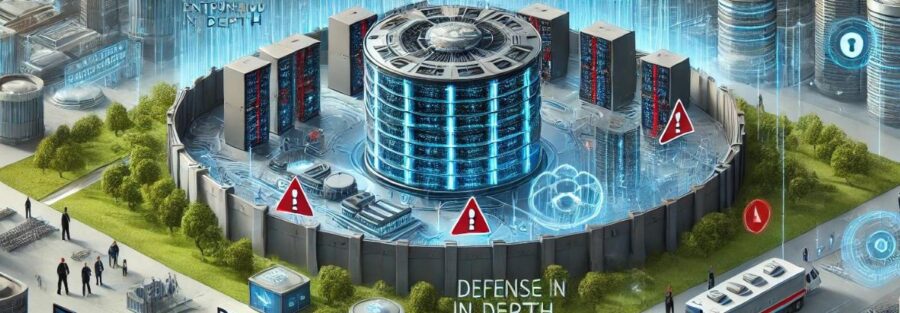Defense in Depth
In the complex and ever-evolving world of cybersecurity, organizations must adopt comprehensive strategies to protect their assets from a wide range of threats. One such strategy is defense in depth, a multi-layered approach designed to provide robust protection against cyber attacks. This blog post delves into the concept of defense in depth, its components, benefits, and best practices for implementation.
What is Defense in Depth?
Defense in depth is a cybersecurity strategy that employs multiple layers of security controls to protect information and systems. The idea is that if one layer of defense is breached, additional layers will still provide protection. This approach acknowledges that no single security measure can be completely foolproof, and therefore, multiple overlapping controls are necessary to mitigate the risk of a successful attack.
Layers of Defense in Depth
Defense in depth involves various layers, each serving a specific purpose in the overall security strategy. These layers include physical security, network security, endpoint security, application security, data security, and human factors.
Physical Security
Physical security is the first line of defense and involves protecting the physical infrastructure of an organization. This includes securing data centers, server rooms, and other critical facilities against unauthorized access, theft, and natural disasters. Measures such as access control systems, surveillance cameras, and environmental controls (e.g., fire suppression and climate control) are essential components of physical security.
Network Security
Network security focuses on protecting the organization’s network infrastructure from unauthorized access, misuse, and attacks. This layer includes firewalls, intrusion detection and prevention systems (IDS/IPS), virtual private networks (VPNs), and network segmentation. These measures help to monitor, control, and secure network traffic, preventing unauthorized access and potential data breaches.
Endpoint Security
Endpoint security involves securing devices such as computers, smartphones, and tablets that connect to the organization’s network. This layer includes antivirus software, endpoint detection and response (EDR) solutions, and mobile device management (MDM) systems. Ensuring that endpoints are protected helps to prevent malware infections, unauthorized access, and data leakage.
Application Security
Application security focuses on protecting software applications from vulnerabilities and attacks. This layer includes secure coding practices, application firewalls, and regular security testing (e.g., penetration testing and code reviews). Ensuring that applications are secure helps to prevent exploitation of vulnerabilities that could lead to data breaches or system compromises.
Data Security
Data security involves protecting the integrity, confidentiality, and availability of data. This layer includes encryption, access controls, and data loss prevention (DLP) solutions. Ensuring that data is secure helps to prevent unauthorized access, modification, or destruction of sensitive information.
Human Factors
Human factors refer to the role that people play in the overall security posture of an organization. This layer includes security awareness training, policies and procedures, and incident response plans. Ensuring that employees are educated about security best practices and aware of potential threats helps to reduce the risk of human error and social engineering attacks.
The Benefits of Defense in Depth
Defense in depth offers several key benefits that enhance an organization’s cybersecurity posture. These benefits include enhanced security, increased resilience, improved detection and response, and compliance with regulatory requirements.
Enhanced Security
By implementing multiple layers of security controls, defense in depth provides comprehensive protection against a wide range of threats. Each layer serves as a barrier, making it more difficult for attackers to breach the organization’s defenses. This multi-layered approach helps to protect against both external and internal threats.
Increased Resilience
Defense in depth increases the resilience of an organization by ensuring that if one layer of defense is compromised, other layers still provide protection. This redundancy helps to minimize the impact of a successful attack and allows the organization to continue operating while addressing the breach.
Improved Detection and Response
Multiple layers of defense provide greater visibility into potential threats and improve the organization’s ability to detect and respond to incidents. By employing a variety of security controls, organizations can identify suspicious activity more quickly and take appropriate action to mitigate the threat.
Compliance with Regulatory Requirements
Many regulatory frameworks and industry standards require organizations to implement comprehensive security measures. Defense in depth helps organizations meet these requirements by providing a structured approach to implementing and maintaining security controls. Compliance not only helps organizations avoid legal and financial penalties but also builds trust with customers and partners.
Best Practices for Implementing Defense in Depth
To effectively implement defense in depth, organizations should follow best practices that ensure a comprehensive and cohesive security strategy. These best practices include risk assessment, layered security controls, continuous monitoring, and regular updates and testing.
Risk Assessment
Conducting a thorough risk assessment is the first step in implementing defense in depth. This involves identifying and evaluating potential threats, vulnerabilities, and the impact of a successful attack. A risk assessment helps organizations prioritize security measures and allocate resources effectively.
Layered Security Controls
Implementing a combination of preventive, detective, and corrective controls across multiple layers is essential for a robust defense in depth strategy. Preventive controls aim to stop attacks before they occur, detective controls identify and alert on suspicious activity, and corrective controls mitigate the impact of an attack.
Continuous Monitoring
Continuous monitoring is critical for maintaining an effective defense in depth strategy. This involves real-time monitoring of network traffic, system activity, and security events to detect and respond to potential threats promptly. Security information and event management (SIEM) solutions and intrusion detection systems (IDS) are valuable tools for continuous monitoring.
Regular Updates and Testing
Regularly updating and testing security controls is crucial for maintaining their effectiveness. This includes applying security patches, conducting vulnerability assessments, and performing penetration testing. Regular updates and testing help to identify and address new vulnerabilities and ensure that security controls remain effective against evolving threats.
Challenges and Considerations
While defense in depth is a powerful strategy, it is not without challenges. Organizations must consider factors such as resource allocation, integration of security controls, and the potential for complexity.
Resource Allocation
Implementing multiple layers of security controls requires significant resources, including time, budget, and personnel. Organizations must carefully allocate resources to ensure that all layers are adequately protected without overburdening the security team.
Integration of Security Controls
Ensuring that security controls across different layers work seamlessly together can be challenging. Organizations must integrate various tools and technologies to create a cohesive security strategy. This may involve using security orchestration platforms and standardized protocols to facilitate communication and collaboration between different security controls.
Potential for Complexity
Defense in depth can introduce complexity to the security environment, making it more difficult to manage and maintain. Organizations must balance the need for comprehensive security with the need for simplicity and manageability. This may involve adopting a risk-based approach to prioritize the most critical security measures and streamline processes.
Real-World Examples of Defense in Depth
Many organizations have successfully implemented defense in depth strategies to protect their assets. Consider the following examples:
A healthcare organization implemented defense in depth by deploying physical security measures, network segmentation, endpoint protection, and robust access controls. Additionally, they conducted regular security awareness training for staff and implemented an incident response plan to address potential breaches.
A financial institution adopted defense in depth by using firewalls, intrusion detection systems, and data encryption to protect sensitive customer information. They also established a security operations center (SOC) to monitor and respond to security events in real-time.
Defense in depth is a comprehensive and effective strategy for protecting organizations from a wide range of cyber threats. By implementing multiple layers of security controls, organizations can enhance their security posture, increase resilience, improve detection and response capabilities, and achieve compliance with regulatory requirements. Following best practices such as conducting risk assessments, implementing layered security controls, continuous monitoring, and regular updates and testing, organizations can successfully implement defense in depth and protect their critical assets from cyber attacks.



